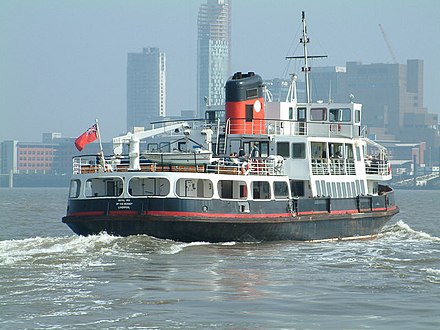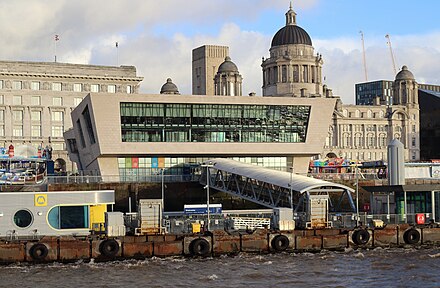Mersey Ferry
Mersey Ferry operates hourly service on the River Mersey between Liverpool, Seacombe (Wirral) and Woodside near Birkenhead (Wirral). Manchester Ship Canal cruise operates by Mersey Ferry to Salford Quays. It does not generally serve Twelve Quays Ferry Terminal in Birkenhead.
Understand
History
 A ferry has crossed the Mersey between Liverpool and Birkenhead since 1150, though the original eastern end of the route was in "the Pool", now Salthouse Dock. In this era, it was the only way for most people to cross the river without undertaking a detour by road via Warrington, which at the time would have added days to any journey. From its inception until the English Reformation (mid-16th century), the ferry service was provided by Benedictine monks of Birkenhead priory, who used to row passengers across the much wider river for a small fare. The ferry was taken over by private enterprise in 1544, and small sailing ships replaced the rowing boats.
A ferry has crossed the Mersey between Liverpool and Birkenhead since 1150, though the original eastern end of the route was in "the Pool", now Salthouse Dock. In this era, it was the only way for most people to cross the river without undertaking a detour by road via Warrington, which at the time would have added days to any journey. From its inception until the English Reformation (mid-16th century), the ferry service was provided by Benedictine monks of Birkenhead priory, who used to row passengers across the much wider river for a small fare. The ferry was taken over by private enterprise in 1544, and small sailing ships replaced the rowing boats.
By the 18th century, as England began to industrialise and Liverpool grew, these ships were becoming an inadequate means of assuring a regular ferry service for an increased demand; sailing ships need wind to work, and the Mersey is notorious for its thick, still winter fogs that can last for days. So, almost as soon as the technology was available (c. 1815), paddle steamers were brought in. The 19th century saw numerous steamship companies competing for dominance along various routes between the Merseyside boomtowns, that is until local governments took over their running in the 1850s and 1860s. This time of innovation also gave rise to new ways of crossing the river: a railway bridge opened between Widnes and Runcorn in 1868, and in 1886 a rail tunnel was dug from Liverpool to Birkenhead, meaning the ferries had quicker (and dryer!) competition. However, the ferries remained popular with cargo and commuters through the replacement of paddle steamers with propeller-driven diesel boats, until the opening of the Queensway road tunnel in 1934; almost overnight, the Seacombe ferry lost two million passengers, and demand for cargo vanished altogether.
Mersey Ferry ships contributed to both World Wars: in 1918, two steamers were used as troop ships and saw action at Zeebrugge, which earned the company the right to use the moniker Royal- in its ship names, while in 1941 the ferries helped to unload American aircraft from transatlantic ships at anchor mid-river to Liverpool. But neither of these honours were to save the service from declining in popularity still further postwar. A second road tunnel (Kingsway) opening in 1971 and the completion of the underground Merseyrail city centre loop in 1977 were the final nails in the coffin for the Mersey Ferry as a commuter service, and since the 1980s the remaining two boats have pivoted towards tourism. This pivot has proved successful, as Merseyside itself has reversed its own seemingly terminal decline of the late 20th century, to become one of the most visited urban areas in the UK, and thanks to a certain famous song - and Liverpool's amazing skyline - the ferry is now pretty much a must-do for any visitor.
Present service
The Mersey Ferry is operated by Merseytravel, the local transport authority which also runs Merseyrail, and owns and tolls the road tunnels. In 2020, two vessels - MV Royal Iris of the Mersey (i.e. the trad black and white one) and MV Snowdrop (i.e. the Sgt. Pepper "dazzle" one) - ply the Mersey, and a further two locally-built low-carbon ferries are set to join the fleet this decade. A commuter service runs every 20 minutes Monday-Friday between Liverpool Pier Head and Seacombe, while the popular 50-minute river cruise also takes in Birkenhead Woodside and runs eight days a week. Fares are £2.80 for an adult single (£3.60 return), and £1.40 for a child single (£1.80 return). Other themed cruises - nighttime, birdwatching, Manchester Ship Canal, Liverpool Bay - operate at various times and charge special fares.
Get in

- Pier Head Ferry Terminal, Liverpool (nearest train station is James St in Liverpool), 53.4047°, -2.9973°, +44 151 330 1003. includes cafe, toilets, Matou restaurant, the Beatles Story, two shops and fab4d cinema. 2019-09-07
- Woodside Ferry Terminal, Woodside, Wirral (nearest train station is Hamilton Square in Birkenhead and small bus station outside), 53.3955°, -3.0087°, +44 151 330 1003. includes toilets, cafe with great views upstairs indoors and outdoors across the River Mersey to Pier Head and Liverpools waterfront. Also includes a 19th-century submarine and tram inside the building from Wirral tramway 2019-09-07
- Seacombe Ferry Terminal, Victoria Place, Seacombe, Wallasey, Wirral, CH44 6QY (a long promenade runs from here along Wirrals scenic coast, not near train station, but bus services operate), 53.4099°, -3.0160°, +44 151 330 1003. includes cafe, toilets and play centre 2019-09-07
- Salford Quays, The Quays, Salford, Lancs, M50 3AH, +44 151 330 1444. No facilities, berthing only. 2019-09-07
See
.jpg/440px-MV_Snowdrop_and_Royal_Princess,_River_Mersey_(geograph_4577305).jpg)
- Dazzle Ferry (MV Snowdrop), +44 151 330 1003. Camouflage colours and patterns as used in war. 2019-09-07
Woodside
- U boat story, Woodside Ferry Terminal, Wirral, +44 151 330 1003. 10AM-6:30PM. featuring U-534 in cross sections and small exhibition. Admittance included in River Explorer Cruise. 2019-09-07
- Wirral Tramway, Woodside, +44 151 647 2128. Weekends and Bank Holiday Mondays 1–4:30PM. half hourly return service between Woodside Ferry Terminal and Wirral Transport Museum £2 adults £1.50 children 2019-09-07
- Wirral Transport Museum, 1 Taylor St, Birkenhead, CH41 1BG, +44 151 647 2128. Weekends and Bank Holiday Mondays 1–4:30PM. includes tea room and toilets 2019-09-07
- Resurgam replica, Woodside Ferry Terminal (Woodside near Hamilton Square, Birkenhead). 24 hr. Victorian wooden submarine replica. 2019-09-08
Pier Head, Liverpool
- The Beatles Story and Fab 4d cinema (Pier Head Ferry Terminal, Liverpool), +44 151 709 1963. One attraction ticket can cover both of these and the main Beatles Story in the Albert Dock. 2019-09-07
- British Music Experience, Cunard building, Pier Head, Liverpool, +44 151 519 0915. 10AM-6PM. 2019-09-07
Do
.jpg/440px-Old_Quay_Bridge_fully_opened_for_Royal_Iris_(2017).jpg)
- Commuter service, +44 151 330 1003. 10 min in the morning and evening direct to Pier Head. 2019-09-07
- River Explorer Cruise. 50 min, it calls at Pier Head, Seacombe and Woodside and includes access to U-boat story. For an extra cost you can include a hop on hop off bus tour in Liverpool. This is the best for tourists. 2019-09-07
- Manchester Ship Canal Cruise, Salford Quays, +44 151 330 1003. 6 hours between Liverpool or Seacombe and Salford with coach return. It does not call at Woodside, but does travel via Eastham ferry entrance to the ship canal. 2019-09-07
- Summer Evening Cruise. They operate only on the river Mersey. 2019-09-07
Buy
- Pier Head Ferry terminal shop. On the ground floor of the Pier Head ferry terminal. 2019-09-07
Eat
- Royal Iris of the Mersey onboard shop. 2019-09-07
- Matou (Pier Head Ferry Terminal, Liverpool), 2nd floor, Georges Parade Pier Head, Mersey Ferry Terminal, Liverpool L3 1DP, +44 151 236 2928. Noon-11PM. Pan-Asian cuisine with excellent indoor and outdoor views whilst dining across the Mersey to Wirral. 2019-09-07
Drink
- The Fab4 cafe (Pier Head Ferry Terminal), +44 151 709 1963. A ground floor cafe with lift access to upper level. 2019-09-07
Sleep
- Crowne Plaza, St Nicholas Place, Princes Dock, Liverpool, +44 151 243 8000, enquiries@cpliverpool.com. The nearest hotel to any of the ferry terminals. 2019-09-07
Mersey Ferry
Timezone:MultipleCoordinates:53.42, -3.02